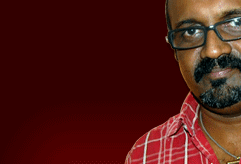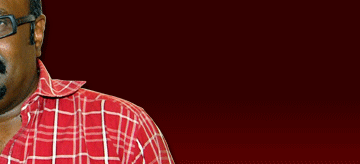| |
|
|
He’s
so busy he had to say no to Kamal Haasan five times. Arguably
India’s most sought after cinematographer, Ravi K Chandran
actually found the dates to talk at length to Behindwoods.
Find out why he has a framed letter of Amitabh Bachchan in
his house, the difference between Surya and Aamir Khan in
Ghajini, why Mani Ratnam and he work so well, which Tamil
directors he would like to shoot for, the cinematographer
he considers his guru, and his secret tip to becoming a great
cameraman.
|
|
Cinematographer
who said no to Kamal five times. |
|
BW:
Did Kamal first ask you to shoot Dasavatharam?
RKC
(laughs) I’m proud to say he is a friend. I can hardly
believe it myself. I grew up being a fan, and today to even
get a call from him – irrespective of whether it is
to ask me to shoot for him or not – is an honor. The
same with writer Sujatha. I grew up reading him, and now to
have worked with him closely is something I still can’t
get over. Yes, Kamal did ask me but unfortunately I couldn’t
give him the dates he wanted. He asked me to shoot Marmayogi
also, but I had to disappoint him there as well. In fact,
he had asked me for Virumandi, Thenali – but each time,
I had to say no. I don’t know what it is: whenever Kamal
has a shoot in mind, my dates are tied up.
What do you think of cinematography in Tamil cinema?
From my college days I remember it as being impressive.
Right from Balu Mahendra and Ashok Kumar to the cameramen
now have been revolutionaries in the art. Hindi cinema and
Malayalam cinema looks to them for artistic and technical
excellence. You could say Tamil cinematographers have been
the most inspiring in the field.
|
|
Tamil
movies struggle to be recognized. Hindi movies get
all the attention. Why?
Hindi
movies simply have a larger Diaspora audience.
More
recently, however, Tamil films have begun to aim to
be grand and awesome.
Grand
is not necessarily in budget or scale alone but in
terms of ideas. In this sense, for me Paruthiveeran
is awesome. |
|
“Kamal
asked me to also
shoot Marmayogi ”
|
|
|
|
On more than one cinematographer working on the same film
A
cameraman commits to different dates for shooting, and for
some unexpected reason, the shooting is delayed, but he has
to keep his commitment to another film, and so another cameraman
moves in and completes the film. This happens in Hollywood,
too. Nestor Almendross, a famous cinematographer while working
on a movie called Days of Heaven, had to move on because it
took too much time to complete. Another cameraman completed
the remaining film. But Oscars were awarded to both cinematographers.
That has happened here with Anniyan: Ravi Varman worked on
it after Manikandan’s dates were over. Both were recognized
and awarded. It has happened to me as well: after Venu had
finished in Minasara Kanavu, I went on to shoot the rest.
Both of us were credited, both got awards.
The relationship between
director and cinematographer
Well,
as long as there are no ego hassles, it works out smoothly.
The
awards you have received?
Quite
a few. In Malayalam cinema, Tamil cinema, Filmfare awards.
Around 30 or 40 awards.
The
project you’re shooting now.
One
is directed by Aditya Chopra and stars SRK. Chopra directs
quickly and is up to date with filmmaking techniques even
though he is making a film after many years. So much so, that
we are now ahead of our shooting schedule. That’s one
reason I even got this holiday and am able to speak to you!
The other, of course, is Ghajini.
On
the differences between the Tamil and Hindi version of Ghajini.
Many
differences. First of all, in Hindi cinema they now use synch-sound.
This means spot dubbing – you record the actor’s
voices as they speak and emote using a mike on the spot itself.
It isn’t dubbed again in the studio. The sound is more
natural this way. Every modulation in the actor’s voice
is captured. Asin is speaking Hindi in her own voice. That
will be another interesting difference. Rahman has scored
the songs here. In Tamil, the cinematography by R.D.Rajasekar
was very good- he even got an award for it. What we’ve
been trying to do is to see if we can, as crew and cast, do
something even better. This is director Murgadoss’s
first outing in Hindi and we all thought it might be difficult
for him with a new language, but he finds it easy. And in
fact, Aamir Khan and the director have even become good friends.
That’s the kind of rapport with which they are working!
Murgadoss is going to become a very big director after the
Hindi Ghajini.
|
|
“For
just one particular
shot, Aamir spent an entire year in training.
”
|
|
The difference here between Surya and Aamir Khan
With
Surya, I’ve worked on only one movie. That was
Aythutha Eluthu. We didn’t have much time to
interact there at all. With Aamir I’ve worked
on three films. Surya is a younger actor, Aamir more
experienced but both are hard working and very committed.
Both are powerful actors. At 42, Aamir worked towards
a six pack body. For just one bare-bodied scene,he
spent a whole year developing his six pack. That's
his dedication.
On
the close understanding between Mani Ratnam and you
Even
before we worked on several projects, I was his assistant
for two films. From then on, we understood how each
other worked, how each other thought. He would treat
me as a brother.
|
|
|
And now you mostly seem to be doing Hindi movies.
See,
those days Bollywood used to hire equipment from Madras studios
or even come and shoot here, but now they’ve got all
the state of the art equipment and work very professionally.
The lighting team is very efficient and so it is less stressful
to work there. Also, Hindi movies have a worldwide audience.
The work that I do is recognized internationally. For instance,
the work that I did for Kannathil Muthamitaal was appreciated
here but what I did for Black was noticed abroad. Hindi movies
have a wider reach. Unfortunately, Tamil cinema doesn’t
have that kind of reach yet.
Sanjay
Leela Bhansali, Mani Ratnam-who is more interesting to work
with?
It
is easy to work with Mani Sir because we communicate so well.
He is a tough taskmaster, does everything quickly but without
compromising on quality. Bhansali takes a lot of time to set
up a shot, and this gives me more time to set up lighting.
His main focus is on being lyrical in every shot, and so he
ponders a lot, giving the cameraman time to think of setting
up the shot. Mani Sir will be more realistic, use available
light more than artificial lighting. So, they have two very
different filmmaking styles.
From
Virasat to Black: what have you learnt about your craft?
I’ve
learnt from my mistakes. You could say Black’s quality
is the result of the twenty years of learning the art and
craft of cinematography the hard way- making mistakes and
like net practice in tennis, constantly improving your game,
your serve, your art. It doesn’t come overnight.
Why
do Hindi movies look more glossy than Tamil?
Surya
once asked me: How come your work looks better in Hindi than
Tamil cinema? I answered simply: the make-up and costume they
use there is of a more sophisticated kind. Several of them
are trained internationally and bring a certain amount of
glossiness to the look of a scene. But in Tamil cinema, the
characters are realistic, more down to earth. Not urban, rich
and hip. Take Vijay in Kuruvi – he plays a local guy,
an ordinary chap. So the make up here can only be low key.
But in Sivaji, Rajini is playing someone glamorous, and so
the make up is rich. So in one you get the realistic look
of a Ram Gopal Verma movie, in the other the glamorous look
of an SRK movie. |
The
struggle of South Indian artists in Bollywood
Not
really. Actually, we are hugely respected there. And
anyway, what is this South Indian-North Indian divide?
We are all Indians and pay our taxes to the same country.
So many South Indians are big there – Hema Malini,
Sri Devi, Aishwarya Rai- and here we have Simran, Jyothika,
Kusbhoo. We are one big movie family, that’s all.
Should
directors know camera movements, etc?
Not
necessary at all. The most important thing is the script.
They should have a good script and leave the actual
shooting to us. If you look at assistant directors in
Tamil cinema: they make a debut movie with a good story.
That’s what gets them the job of making their
own movie. If you see Ghajini, there is no need for
Murgadoss to know the camera. R.D. Rajasekar knows enough
for both of them! The strength of Ghajini is the story.
|
|
“The
most inspiring
cinematographers
in India
have
all come from Tamil cinema.”
|
|
|
Do actors request you to shoot them from certain angles alone?
Well,
you know, they are only human. So, yes, they would like you
to shoot them from certain angles, use a certain kind of lighting,
to be consistent with the style of their acting. But this
comes over time, with trained actors. If you take the early
films of Vijay, for instance – is the look he has there
the same today? He has realized what looks and angles work
for him, what his fans have come to enjoy, and would like
the cameraman to tease out that typical Vijay style from every
shot. So he request particular shots and angles.
In
Bollywood the script and shot break down is ready two months
ahead. This is not so in Tamil movies.
I
think this is why the budgets overshoot in Tamil movies and
there are delays.
What
are the Tamil movies that have amazed you without using big
technology?
16
Vaidyanale. It’s stunning. And many classic Tamil movies.
How
impressed are you with Dasavatharam?
I
haven’t seen it yet.
Your
experience with Amitabh Bachchan?
When
he was given the best actor Filmfare award for Black, he thanked
all the technical crew by name but forgot to mention me. Apart
from him and the director, I was the only other one who had
got an award for Black, so I was puzzled but forgot about
the incident. One month later, he calls my office and finds
out my address. And sends a handwritten note of apology for
forgetting to mention me that night, called my work great,
and included a bouquet and a box of chocolates. Such an iconic
actor needn’t have made such a gesture. I have the letter
framed in my house.
Though
you don’t have the dates, if you could work with Tamil
directors, who would they be?
Selvaraghavan,
Ameer, Bala.
Your
other projects?
Nandita
Das’s In Such Times, two movies with SRK, one directed
by Aditya Chopra, the other by Karan Johar, which also stars
Kajol.
Cinematographers
you admire
Vincent master, Loknath, and Karnan from the old days. I like
the way Karnan made films. Balu Mahendra, Ashok Kumar, Santosh
Sivan, PC Sriram, Ramjee, Rajiv Menon, Balasubramaniam, Mahi,
K.V. Anand.
Your
guru?
My
brother Ramchander. Rajiv Menon, who introduced me to Ad films.
Anything
to say to young cinematographers?
Don’t be afraid to experiment. Don’t play it safe.
Take risks. Balu, P.C., Sivan –they have all experimented,
created benchmarks and set trends. It’s a privilege
to make films, don’t squander the chance. |
| |
 |
|
|
|
|





